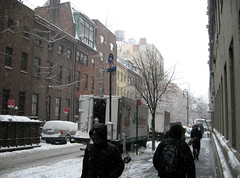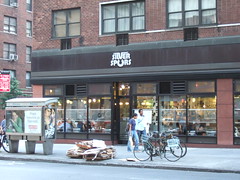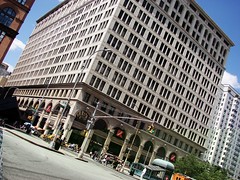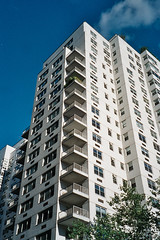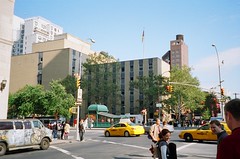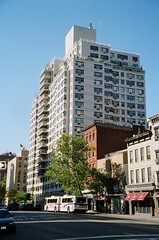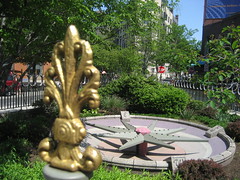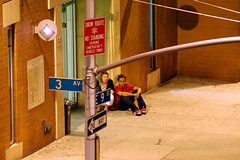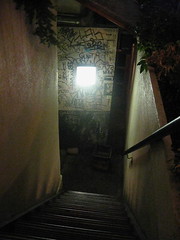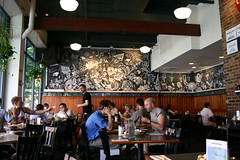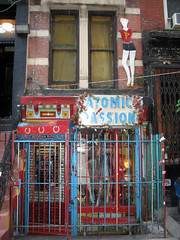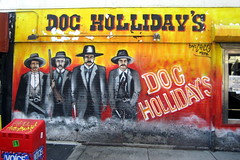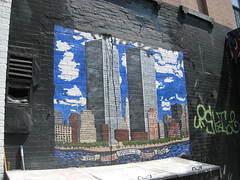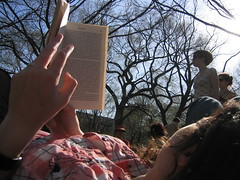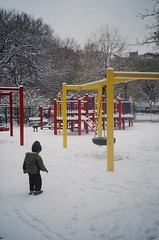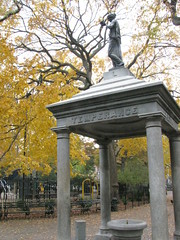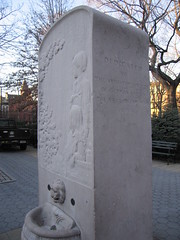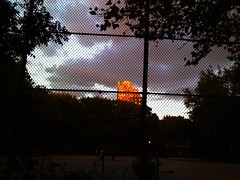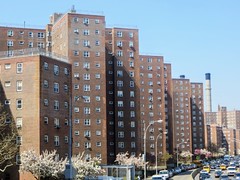South: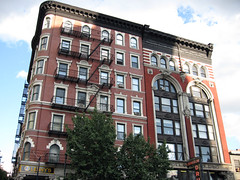
66 (corner): Lenny's, local sandwich chain, was Greenwich Brewing Co., pizza; Hasta La Pasta, Italian. This used to be Trude Heller's, a prominent rock club/disco where First Daughter Lynda Bird Johnson was photographed dancing with tanned actor George Hamilton in 1965; the Manhattan Transfer got their start here. Earlier this was Paul and Joe's Bar, a main gay rendezvous in the early 1920s. 64: A deli called Farmer's Market. Humorist S.J. Perelman lived here (1929-30). 62: Village, new French-American noted for its Espressotinis, was The Lion, a gay bar where Barbra Streisand, Joan Rivers had early gigs. Earlier it was the Golden Eagle, a French-Italian restaurant described by the WPA Guide as an "old Greenwich Village place." 58: A five-story building from 1853. 46-50: Hampshire, a six-story apartment building from 1883. Novelist Dawn Powell lived here 1924-28. While living here her first novel, Whither, was published, and she wrote She Walks in Beauty and The Bride's House. 38-44: Portsmouth, a six-story double apartment building dating to 1882. (Portsmouth is a city in the English county of Hampshire.) Joseph Papp, founder of the Public Theater and the New York Shakespeare Festival, lived here from 1973-91. 36: Poet Elinor Wylie lived here from 1926 until her death in 1928, along with her husband William Rose Benet. 26: The Prasada, a nine-story 1920s
apartment building in neo-Georgian style, takes
its name from the Sanskrit word for ''temple.''
12: Home of Henry Jarvis Raymond (1860-67), first editor of both the New York Times and Harper's Magazine. 10: "Ashcan School" painter
William Glackens lived in
this building from the 1910s until his death in 1938. Note
large north-facing studio windows.
Corner (20 5th Ave): This 17-story red-brick building went up in 1941, but the rounded indentations in the facade to create bay windows make it look considerably younger. Designed by Boak & Paris, architects noted for their innovative work. |
W
|
North:Citarella69 (corner): Formerly Balducci's gourmet market; started in 1916 as a Brooklyn pushcart, it moved in 1972 to this location. In 1999 family squabbles forced the sale of the business to a D.C.-based chain, which went under when its "Balducci.com" scheme fell victim to the dot.com bust. Now in the space is another local gourmet grocery chain owned by Joe Guerra, who got his start wrapping flounder at the Fulton Fish Market; he has a reputation as a union-buster. Barbra Streisand had an apartment here when she was playing The Lion. The 13-story building is from 1956--perhaps one of the first of the hideous white-brick apartment buildings that went up in that era. 9th Street PATH Station
Underneath No. 69 is the entrance to New York City's other subway system--the Port Authority Trans-Hudson, which connects the southwest portion of Manhattan to Hoboken, Jersey City and Newark. Opened in 1907 as the Hudson & Manhattan Railroad, it was taken over by the Port Authority in 1962. 61: Windsor Arms, a nine-story ''vaguely Georgian'' building built in 1926. An interesting diamond pattern in the brickwork. 35: A nine-story apartment building from 1926. Anais Nin lived here in the early 1950s. Later poet Marianne Moore lived here, in Apartment 7B, from 1966 until her death in 1972. 29: Author/artist Maurice Sendak created Where the Wild Things Are here. 19-23: These four-story buildings, built 1870, were from 1877 until 1905 the Hotel Giffrou, operated by Madame Marie Giffrou, a French widow. A bohemian refuge, the hotel was frequented by French and Spanish artists, as well as literary figures like Mark Twain, William Dean Howells and Thomas A. Janvier. Ocean's 21, Rat Pack-themed restaurant at No. 19, was Marylou's, Nat Simon's Penguin. Corner (24 5th Ave): This 15-story building was the Fifth Avenue Hotel, a 1922 effort by Emery Roth. Built on site of the Brevoort House, home of Henry Brevoort Jr., the finest house on 5th Avenue when it was built in 1834 (perhaps designed by Ithiel Town and Alexander Jackson Davis). Now houses Cru, featuring a 222-page wine list with 3,820 vintages, based on the 65,000-bottle collection of Roy Welland, who owned Washington Park, the restaurant that used to be here. Before that (not so long ago) it was Rose Cafe & Bar, featured in As Good as It Gets; earlier known as 24 Fifth. |
